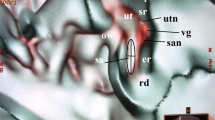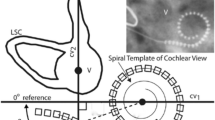Abstract
Three-dimensional (3-D) reconstruction methods were employed to study the anatomy of the vestibular aqueducts (VAs) in ten postmortem temporal bone specimens obtained from ten individuals aged 4 months to 70 years at death. After reconstruction, the ten 3-D images of VAs were superimposed on one another and differences evaluated. The VA showed postnatal growth and variations in size and shape. However, the variations in angle at which the VA bends near the isthmus were not correlated with age. Furthermore, study of the superimposed images revealed that the 3-D course of the VA was essentially the same in individuals of all ages, despite its wide variability in size and shape. These results indicate that the basic course of the VA is determined before early infancy although the VA grows thereafter, suggesting that VA anomalies such as “large vestibular aqueduct syndrome” (in which the VA takes an abnormally straight and wide course) may be established prenatally.
Similar content being viewed by others
References
Anson BJ, Donaldson JA, Warpeha RL, Winch TR (1965) the vestibular and cochlear aqueducts: their variational anatomy in the adult human ear. Laryngoscope 75: 1203–1223
Arenberg IK, Rask-Anderson H, Wilbrand H, et al (1977) the surgical anatomy of the endolymphatic sac. Arch Otolaryngol 103:1–11
Fujita S, Sando I (1994) Postnatal development of the vestibular aqueduct in relation to the internal auditory canal. Ann Otol Rhinol Laryngol 103:719–722
Geurkink NA (1977) Surgical anatomy of the temporal bone posterior to the internal auditory canal: an operative approach. Laryngoscope 87:975–986
Hebbar GK, Rask-Anderson H, Linthicum FH Jr (1991) Threedimensional analysis of 61 human endolymphatic ducts and sacs in ears with and without Meniere's disease. Ann Otol Rhinol Laryngol 100: 219–225
Jackler RK, De La Cruz A (1989) the large vestibular aqueduct syndrome. Laryngoscope 99:1238–1243
Kartush JM, Telian SA, Graham MD, et al (1986) Anatomic basis for labyrinthine preservation during posterior fossa acoustic surgery. Laryngoscope 96:1024–1028
Kodama A, Sando I (1982) Dimensional anatomy of the vestibular aqueduct and the endolymphatic sac (rugose portion) in human temporal bones. Ann Otol Rhinol Laryngol 91 [Suppl 96]:13–20
Kodama A, Sando I (1982) Postnatal development of the vestibular aqueduct and endolymphatic sac. Ann Otol Rhinol Laryngol 91 [Suppl 96]:3–12
Saito R, Ohmichi T, Hayashi S, et al (1988) Visualization of human vestibular aqueduct with computer-aided serial section reconstruction system. Acta Otolaryngol (Stockh) [Suppl] 447 100–104
Sato H, Sando I, Takahashi H, et al (1993) Torsion of the human semicircular canals and its influence on their angular relationships. Acta Otolaryngol (Stockh) 113:171–175
Stahl J, Wilbrand H (1974) The vestibular aqueduct in patients with Meniere's disease. Acta Otolaryngol (Stockh) 78:36–48
Takagi A, Sando I (1989) Computer-aided three-dimensional reconstruction: a method of measuring temporal bone structures including the length of the cochlea. Ann Otol Rhinol Laryngol 98:515–522
Watzke D, Bast TH (1950) The development and structure of the otic (endolymphatic) sac. Anat Rec 106:361–379
Author information
Authors and Affiliations
Rights and permissions
About this article
Cite this article
Fujita, S., Sando, I. Three-dimensional course of the vestibular aqueduct. Eur Arch Otorhinolaryngol 253, 122–125 (1996). https://doi.org/10.1007/BF00615107
Received:
Accepted:
Issue Date:
DOI: https://doi.org/10.1007/BF00615107




